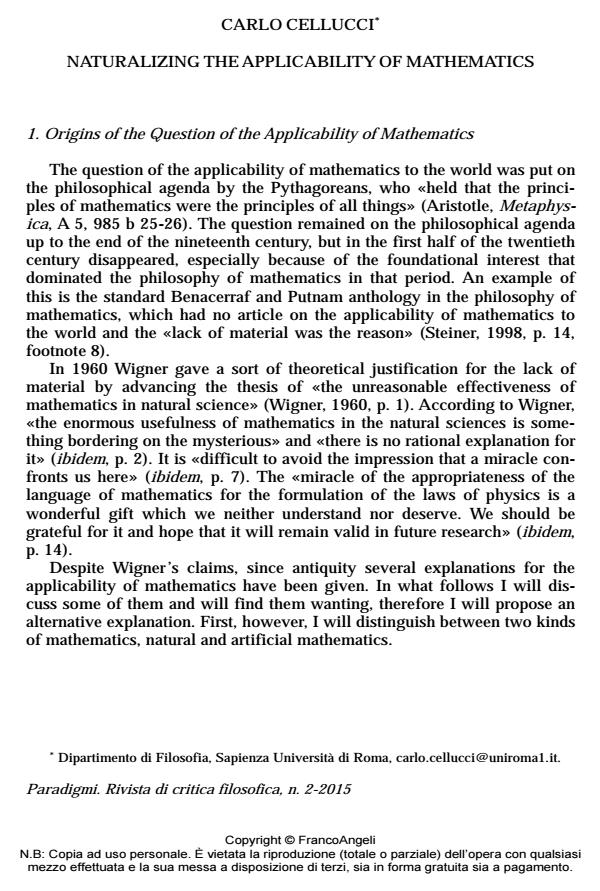Naturalizing the Applicability of Mathematics
Titolo Rivista PARADIGMI
Autori/Curatori Carlo Cellucci
Anno di pubblicazione 2015 Fascicolo 2015/2
Lingua Italiano Numero pagine 20 P. 25-44 Dimensione file 90 KB
DOI 10.3280/PARA2015-002004
Il DOI è il codice a barre della proprietà intellettuale: per saperne di più
clicca qui
Qui sotto puoi vedere in anteprima la prima pagina di questo articolo.
Se questo articolo ti interessa, lo puoi acquistare (e scaricare in formato pdf) seguendo le facili indicazioni per acquistare il download credit. Acquista Download Credits per scaricare questo Articolo in formato PDF

FrancoAngeli è membro della Publishers International Linking Association, Inc (PILA)associazione indipendente e non profit per facilitare (attraverso i servizi tecnologici implementati da CrossRef.org) l’accesso degli studiosi ai contenuti digitali nelle pubblicazioni professionali e scientifiche
Per trattare la questione dell’applicabilità della matematica questo articolo distingue tra matematica naturale, cioè matematica innata, e matematica artificiale, cioè matematica come disciplina. Esso sostiene che la matematica naturale è applicabile al mondo perché i sistemi di conoscenze di base su cui si fonda, essendo un risultato dell’evoluzione biologica, sono adatti a certe proprietà matematiche del mondo. Dall’altro lato, la base dell’applicabilità della matematica artificiale al mondo sta nella rivoluzione filosofica di Galileo, la decisione di limitare la fisica allo studio di alcune proprietà del mondo di carattere matematico. Ma, come l’applicabilità della matematica naturale, anche l’applicabilità della matematica artificiale dipende dalla nostra costituzione biologica, e perciò in ultima analisi dall’evoluzione biologica
Parole chiave:Applicabilità, concettualizzazioni, evoluzione, matematica, semplicità.
- Kepler J. (1937-). Gesammelte Werke, ed. by von Dyck W., Caspar M. and Hammer F. München: Beck.
- Leibniz G.W. (1965). Die Philosophischen Schriften. Hildesheim: Olms.
- Plantinga A. (2011). Where the Conflict Really Lies: Science, Religion, and Naturalism. Oxford: Oxford University Press.
- Poincaré H. (1914). Science and Method. London: Nelson.
- Renfrew A.C., Frith C. and Malafouris L. eds. (2008). The Sapient Mind. Archaeology Meets Neuroscience. Philosophical Transaction of the Royal Society B, 363, 1499.
- Resnik M.D. (1997). Mathematics as a Science of Patterns. Oxford: Oxford University Press.
- Russell B. (1979). The Principles of Mathematics. Cambridge: Cambridge University Press.
- Russell B. (1995). An Outline of Philosophy. London: Routledge.
- Sarukkai S. (2005). Revisiting the “Unreasonable Effectiveness” of Mathematics. Current Science, 88: 415-423.
- Schwartz J. (1992). The Pernicious Influence of Mathematics on Science. In: Kac
- M., Rota G.-C. and Schwartz J., eds., Discrete Thoughts. Boston: Birkhäuser: 19-25.
- Spelke E. (2011). Natural Number and Natural Geometry. In: Dehaene S. and Brannon E.M., eds., Space, Time and Number in the Brain. London: Elsevier: 287-317.
- Starr A., Libertus M.E. and Brannon E.M. (2013). Number Sense in Infancy Predicts Mathematical Abilities in Childhood. Proceedings of the National Academy of Sciences USA, DOI: 10.1073/pnas.1302751110
- Steiner M. (1998). The Applicability of Mathematics as a Philosophical Problem. Cambridge (MA): Harvard University Press.
- Tegmark M. (2008). The Mathematical Universe. Foundations of Physics, 38: 101-150. Thurston W. (2011). Foreword. In: Pitici M., ed., The Best Writings on Mathematics 2010. Princeton: Princeton University Press: xi-xiii.
- Weinberg S. (1986). Lecture on the Applicability of Mathematics. Notices of the American Mathematical Society, 33: 725-728.
- Weinberg S. (1993). Dreams of a Final Theory: The Search for the Fundamental Laws of Nature. New York: Vintage.
- Wigner E.P. (1960). The Unreasonable Effectiveness of Mathematics in the Natural Sciences. Communications on Pure and Applied Mathematics, 13: 1-14.
- Ye F. (2010). Strict Finitism and the Logic of Mathematical Applications. Dordrecht: Springer.
- Abbott D. (2013). The Reasonable Ineffectiveness of Mathematics. Proceedings of the IEEE, 101: 2147-2153.
- Atiyah M. (1995). Creation v Discovery. Times Higher Education Supplement, 29 September.
- Bueno O. and Colyvan M. (2011). An Inferential Conception of the Application of Mathematics. Noûs, 45: 345-374.
- Bueno I. and French S. (2012). Can Mathematics Explain Physical Phenomena? The British Journal for the Philosophy of Science, 63: 85-113.
- Cellucci C. (2013). Rethinking Logic: Logic in Relation to Mathematics, Evolution, and Method. Berlin: Springer.
- Colyvan M. (2012). An Introduction to the Philosophy of Mathematics. Cambridge: Cambridge University Press.
- De Cruz H. (2008). An Extended Mind Perspective on Natural Number Representation. Philosophical Psychology, 21: 475-490.
- De Cruz H. and De Smedt J. (2013). Mathematical Symbols as Epistemic Actions. Synthese, 190: 3-19.
- Diels H.A. and Krantz W. (1964). Die Fragmente der Vorsokratiker. Berlin: Weidmann.
- Dirac P.A.M. (1963). The Evolution of the Physicists’ Picture of Nature. Scientific American, 208, 5: 43-53.
- Dirac P.A.M. (1978). Directions in Physics. New York: Wiley.
- Galilei G. (1968). Opere, a cura di A. Favaro. Firenze: Barbera.
- Grattan-Guinness I. (2008). Solving Wigner’s Mystery: The Reasonable (Though Perhaps Limited) Effectiveness of Mathematics in the Natural Sciences. The Mathematical Intelligencer, 30: 7-17.
- Hersh R. (2014). Experiencing Mathematics. What do we do, when we do mathematics? Providence: American Mathematical Society.
- Hilbert D. (1996a). The Knowledge of Nature. In: Ewald W.B., ed., From Kant to Hilbert. A Source Book in the Foundations of Mathematics, vol. 2. Oxford: Oxford University Press: 1157-1165.
- Hilbert D. (1996b). From Mathematical Problems. In: Ewald W.B., ed., From Kant to Hilbert. A Source Book in the Foundations of Mathematics, vol. 2. Oxford: Oxford University Press: 1096-1105.
- Hooker C., ed. (2011). Philosophy of Complex Systems. Amsterdam: North Holland.
- Husserl E. (1970). The Crisis of European Sciences and Transcendental Phenomenology. Evanston: Northwestern University Press.
- Kant I. (2002). Theoretical Philosophy after 1781. Cambridge: Cambridge University Press.
Carlo Cellucci, Naturalizing the Applicability of Mathematics in "PARADIGMI" 2/2015, pp 25-44, DOI: 10.3280/PARA2015-002004